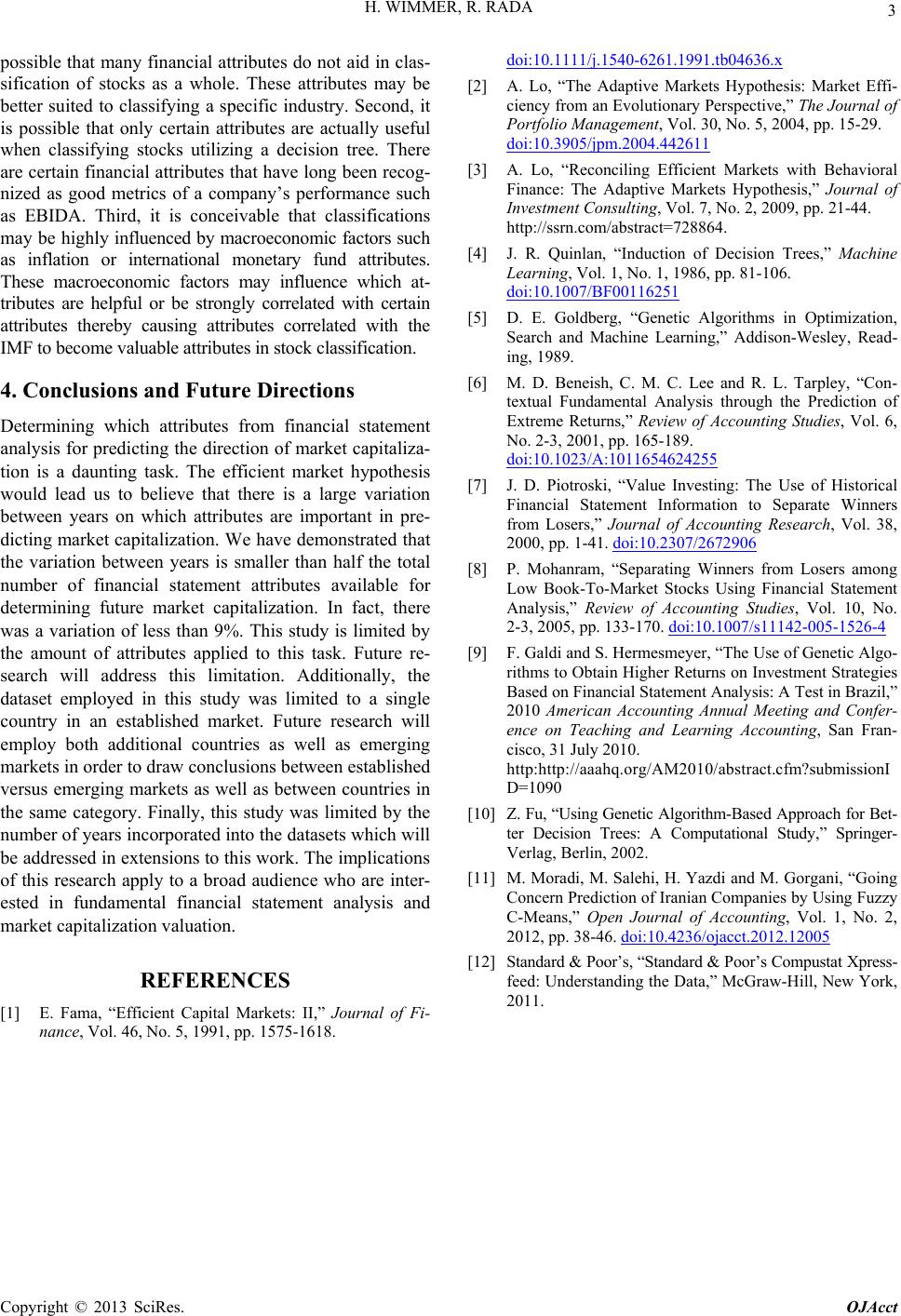
H. WIMMER, R. RADA
Copyright © 2013 SciRes. OJAcct
3
possible that many financial attributes do not aid in clas-
sification of stocks as a whole. These attributes may be
better suited to classifying a specific industry. Second, it
is possible that only certain attributes are actually useful
when classifying stocks utilizing a decision tree. There
are certain financ ial attributes that have long been recog-
nized as good metrics of a company’s performance such
as EBIDA. Third, it is conceivable that classifications
may be high ly influenced by macroecono mic factors such
as inflation or international monetary fund attributes.
These macroeconomic factors may influence which at-
tributes are helpful or be strongly correlated with certain
attributes thereby causing attributes correlated with the
IMF to become valuable attributes in stock classification.
4. Conclusions and Future Directions
Determining which attributes from financial statement
analysis for predicting the direction of market capitaliza-
tion is a daunting task. The efficient market hypothesis
would lead us to believe that there is a large variation
between years on which attributes are important in pre-
dicting market capitalization. We have demonstrated that
the variation between years is smaller than half the total
number of financial statement attributes available for
determining future market capitalization. In fact, there
was a variation of less than 9%. This study is limited by
the amount of attributes applied to this task. Future re-
search will address this limitation. Additionally, the
dataset employed in this study was limited to a single
country in an established market. Future research will
employ both additional countries as well as emerging
markets in order to draw conclusions between established
versus emerging markets as well as between countries in
the same category. Finally, this study was limited by the
number of years incorporated into th e datasets which will
be addressed in extensions to this work. The implica tions
of this research apply to a broad audience who are inter-
ested in fundamental financial statement analysis and
market capitalization valuation.
REFERENCES
[1] E. Fama, “Efficient Capital Markets: II,” Journal of Fi-
nance, Vol. 46, No. 5, 1991, pp. 1575-1618.
doi:10.1111/j.1540-6261.1991.tb04636.x
[2] A. Lo, “The Adaptive Markets Hypothesis: Market Effi-
ciency from an Evolutionary Perspective,” The Journal of
Portfolio Management, Vol. 30, No. 5, 2004, pp. 15-29.
doi:10.3905/jpm.2004.442611
[3] A. Lo, “Reconciling Efficient Markets with Behavioral
Finance: The Adaptive Markets Hypothesis,” Journal of
Investment Consulting, Vol. 7, No. 2, 2009, pp. 21-44.
http://ssrn.com/abstract=728864.
[4] J. R. Quinlan, “Induction of Decision Trees,” Machine
Learning, Vol. 1, No. 1, 1986, pp. 81-106.
doi:10.1007/BF00116251
[5] D. E. Goldberg, “Genetic Algorithms in Optimization,
Search and Machine Learning,” Addison-Wesley, Read-
ing, 1989.
[6] M. D. Beneish, C. M. C. Lee and R. L. Tarpley, “Con-
textual Fundamental Analysis through the Prediction of
Extreme Returns,” Review of Accounting Studies, Vol. 6,
No. 2-3, 2001, pp. 165-189.
doi:10.1023/A:1011654624255
[7] J. D. Piotroski, “Value Investing: The Use of Historical
Financial Statement Information to Separate Winners
from Losers,” Journal of Accounting Research, Vol. 38,
2000, pp. 1-41. doi:10.2307/2672906
[8] P. Mohanram, “Separating Winners from Losers among
Low Book-To-Market Stocks Using Financial Statement
Analysis,” Review of Accounting Studies, Vol. 10, No.
2-3, 2005, pp. 133-170. doi:10.1007/s11142-005-1526-4
[9] F. Galdi and S. Hermesmeye r, “The Use of Genetic Algo-
rithms to Obtain Higher Returns on Investment Strategies
Based on Financial Statement Analysis: A Test in Brazil,”
2010 American Accounting Annual Meeting and Confer-
ence on Teaching and Learning Accounting, San Fran-
cisco, 31 July 2010.
http:http://aaahq.org/AM2010/abstract.cfm?submissionI
D=1090
[10] Z. Fu, “Using Genetic Algorithm-Based Approach for Bet-
ter Decision Trees: A Computational Study,” Springer-
Verlag, Berlin, 2002.
[11] M. Moradi, M. Salehi, H. Yazdi and M. Gorgani, “Going
Concern Prediction of Iranian Companies by Using Fuzzy
C-Means,” Open Journal of Accounting, Vol. 1, No. 2,
2012, pp. 38-46. doi:10.4236/ojacct.2012.12005
[12] Standard & Poor’s, “Standard & Poor’s Compustat Xpress-
feed: Understanding the Data,” McGraw-Hill, New York,
2011.